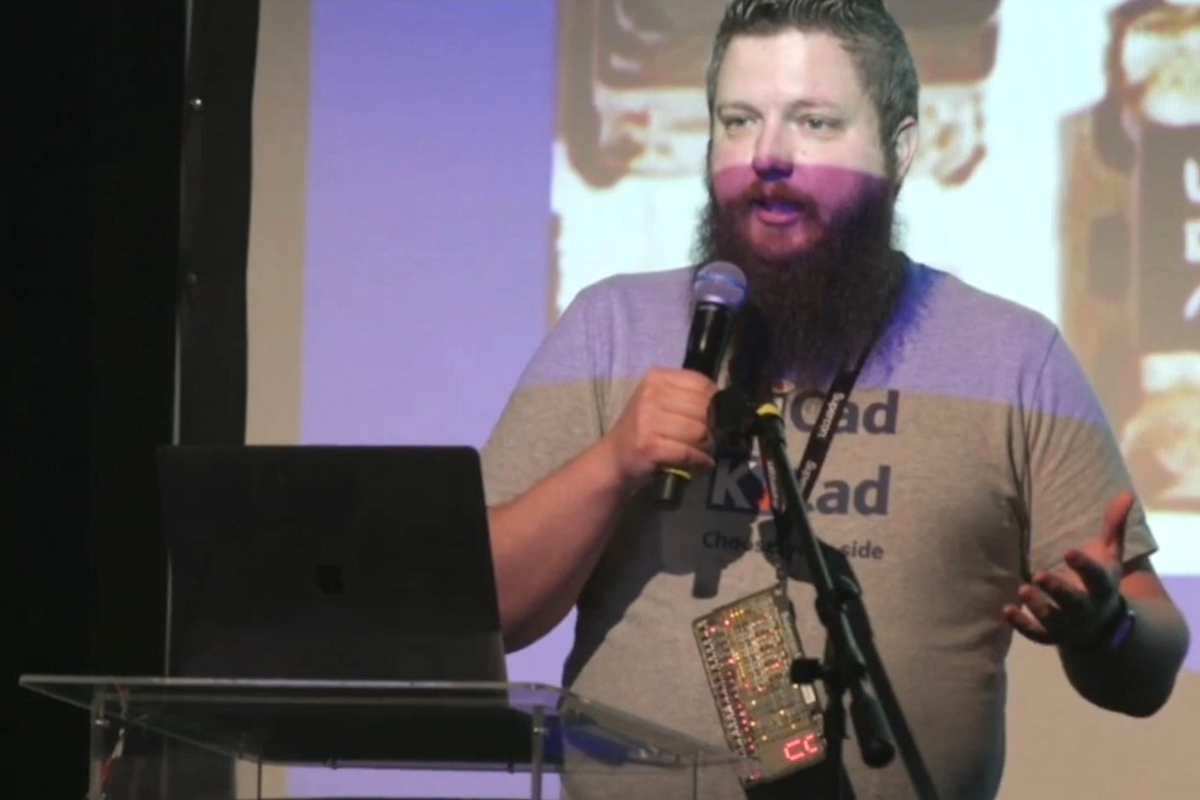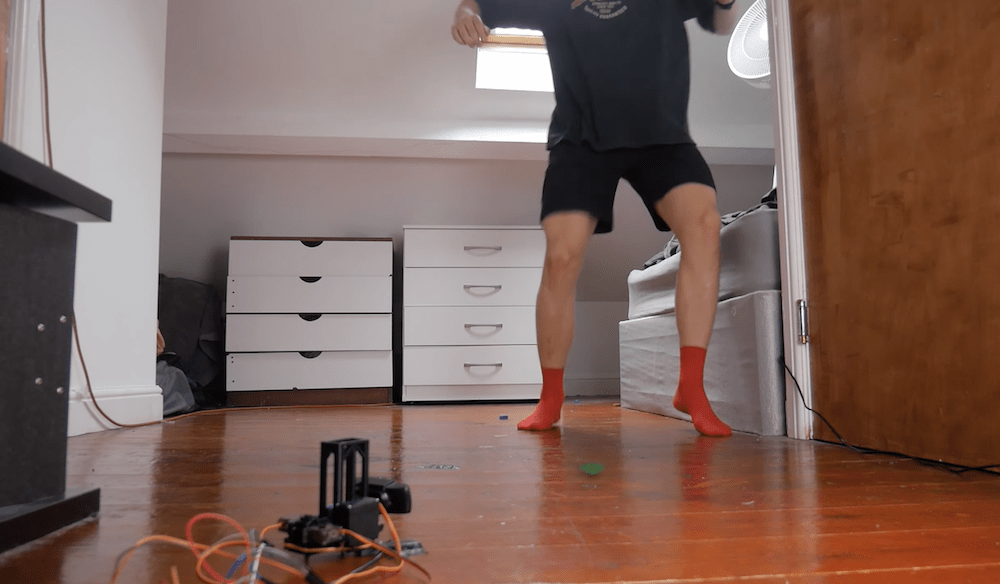Supercon 2022: Michael Whiteley saves the badge
Michael Whiteley (aka [compukidmike]) is a Badgelife celebrity. Together he and his wife Katie form MK Factor. They have created some of the most popular electronic conference badges. Of course, even experts make mistakes and face challenges when they dare to push the boundaries of technology and delivery times. In his Supercon 2022 talk, There's No Rev 2: When Badgelife Goes Wrong, Mike shares details of some of his worst badge problems and also how he gracefully pulled them back from the brink of disaster.
Live the badge lifeAttendees to the world's largest hacker convention, DEF CON in Las Vegas, had already grown accustomed to receiving and wearing some very cool and quirky admission tokens, more accurately known as badges. Then in 2006, at DEF CON 14, everything changed. Designed by Joe Grand, the first electronic DEF CON badge was a printed circuit board comprising a tiny PIC microcontroller, two LEDs and a single push button. Badgelife was born.
DEF CON 30 Human Sampling TableMike begins his war stories with one on the DEF CON 30 badge. It was a Herculean project with 25,000 badges produced in a short period of time in the ever-changing chaos of a collapse of the semiconductor supply chain. Although many consider it one of the best DEF CON badges ever created, the DC30 badge posed a number of challenges for its creators. Microcontrollers were in short supply in 2021 and 2022, forcing the badging team to keep tabs on supplies from component vendors in order to snipe chips as soon as they appeared in stock. The DC30 badge has actually been redesigned several times as different microcontrollers fluctuated in and out of supply.
Last minute changes to an audio amplifier on the DC30 badge were also forced by supply chain shortages. The amplifier modification introduced circumstances where the chip could burn out if the audio cable was looped back from a badge's audio output to its input. It was also discovered that the amplifier chip could burn out if a cord clipped against the badge's audio jack. Unfortunately, this discovery was not made until after the start of the conference. The burning amplifier chips were housed in an almost microscopic BGA (ball grid array) package. At just 1.5mm across, they're not the easiest chips to rework when damaged.
Mike continues to share stories from other badge projects. These include more lanyard clip issues with a SAINTCON badge, broken 0.8mm PCBs, broken leads connected via vias, reversed LEDs, mod wires, silkscreen delays, broken connectors , etc. There are so many details that go into an electronic badge and the failure of one of them can become an obstacle.
do things rightOf course, a big part of learning about all of these issues is how they were mitigated. Handling issues on the fly, as gracefully as possible, is where real expertise comes in. We are fortunate to have forums like Supercon where we can learn from each other's mistakes and hopefully avoid them in the future.
Mike shared how the number of hot amplifier chips at the DC30 was drastically reduced by placing stickers on badge bags and signs around the conference showing how the audio cable did not have to be looped back between output and audio input. Additionally, many people have covered the audio jack pins with tape to prevent shorting against the lanyard clips. And best of all, the Hardware Hacking Village has stepped up to help people perform the difficult BGA redesign on the tiny amplifier chips. Although regression testing after changing the amplifier chip was able to catch some of the issues, quickly identifying root causes and communicating fixes really saved a lot of badges.
For the 2019 SAINTCON badge, Mike detected reversed LEDs during the manufacturing process. The assembly house was able to return them, but only at the cost of late delivery. The billboards did not arrive until the morning of the conference. Mike also nailed a last minute fix with mod threads on a few hundred DC801 badges. And then again stuffing components on all the badges in Car Hacking Village over one last weekend after the board misprinted the PCB silkscreens, causing a major delay in delivery.
Lessons learnedUltimately, Mike sums up the most important lessons he learned from all his adventures with Badgelife: “Time is of the essence. It can be your saving grace or your downfall. a backup plan. Lanyards are a chaotic evil. Badges will break unexpectedly. Test, test and test some more!"

Michael Whiteley (aka [compukidmike]) is a Badgelife celebrity. Together he and his wife Katie form MK Factor. They have created some of the most popular electronic conference badges. Of course, even experts make mistakes and face challenges when they dare to push the boundaries of technology and delivery times. In his Supercon 2022 talk, There's No Rev 2: When Badgelife Goes Wrong, Mike shares details of some of his worst badge problems and also how he gracefully pulled them back from the brink of disaster.
Live the badge lifeAttendees to the world's largest hacker convention, DEF CON in Las Vegas, had already grown accustomed to receiving and wearing some very cool and quirky admission tokens, more accurately known as badges. Then in 2006, at DEF CON 14, everything changed. Designed by Joe Grand, the first electronic DEF CON badge was a printed circuit board comprising a tiny PIC microcontroller, two LEDs and a single push button. Badgelife was born.
DEF CON 30 Human Sampling TableMike begins his war stories with one on the DEF CON 30 badge. It was a Herculean project with 25,000 badges produced in a short period of time in the ever-changing chaos of a collapse of the semiconductor supply chain. Although many consider it one of the best DEF CON badges ever created, the DC30 badge posed a number of challenges for its creators. Microcontrollers were in short supply in 2021 and 2022, forcing the badging team to keep tabs on supplies from component vendors in order to snipe chips as soon as they appeared in stock. The DC30 badge has actually been redesigned several times as different microcontrollers fluctuated in and out of supply.
Last minute changes to an audio amplifier on the DC30 badge were also forced by supply chain shortages. The amplifier modification introduced circumstances where the chip could burn out if the audio cable was looped back from a badge's audio output to its input. It was also discovered that the amplifier chip could burn out if a cord clipped against the badge's audio jack. Unfortunately, this discovery was not made until after the start of the conference. The burning amplifier chips were housed in an almost microscopic BGA (ball grid array) package. At just 1.5mm across, they're not the easiest chips to rework when damaged.
Mike continues to share stories from other badge projects. These include more lanyard clip issues with a SAINTCON badge, broken 0.8mm PCBs, broken leads connected via vias, reversed LEDs, mod wires, silkscreen delays, broken connectors , etc. There are so many details that go into an electronic badge and the failure of one of them can become an obstacle.
do things rightOf course, a big part of learning about all of these issues is how they were mitigated. Handling issues on the fly, as gracefully as possible, is where real expertise comes in. We are fortunate to have forums like Supercon where we can learn from each other's mistakes and hopefully avoid them in the future.
Mike shared how the number of hot amplifier chips at the DC30 was drastically reduced by placing stickers on badge bags and signs around the conference showing how the audio cable did not have to be looped back between output and audio input. Additionally, many people have covered the audio jack pins with tape to prevent shorting against the lanyard clips. And best of all, the Hardware Hacking Village has stepped up to help people perform the difficult BGA redesign on the tiny amplifier chips. Although regression testing after changing the amplifier chip was able to catch some of the issues, quickly identifying root causes and communicating fixes really saved a lot of badges.
For the 2019 SAINTCON badge, Mike detected reversed LEDs during the manufacturing process. The assembly house was able to return them, but only at the cost of late delivery. The billboards did not arrive until the morning of the conference. Mike also nailed a last minute fix with mod threads on a few hundred DC801 badges. And then again stuffing components on all the badges in Car Hacking Village over one last weekend after the board misprinted the PCB silkscreens, causing a major delay in delivery.
Lessons learnedUltimately, Mike sums up the most important lessons he learned from all his adventures with Badgelife: “Time is of the essence. It can be your saving grace or your downfall. a backup plan. Lanyards are a chaotic evil. Badges will break unexpectedly. Test, test and test some more!"
What's Your Reaction?






















